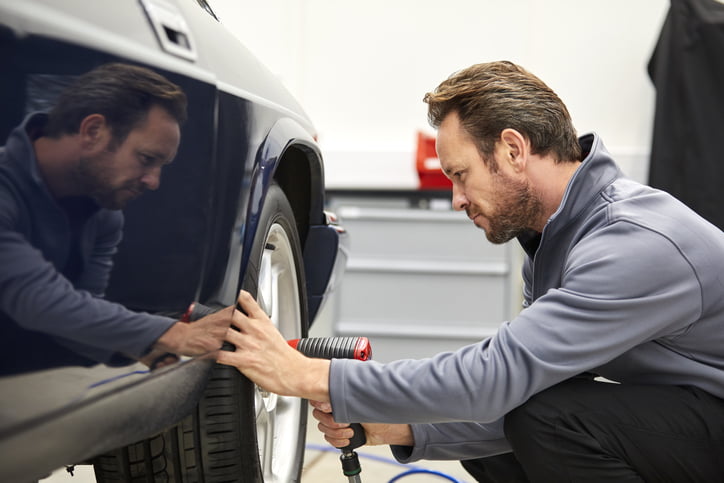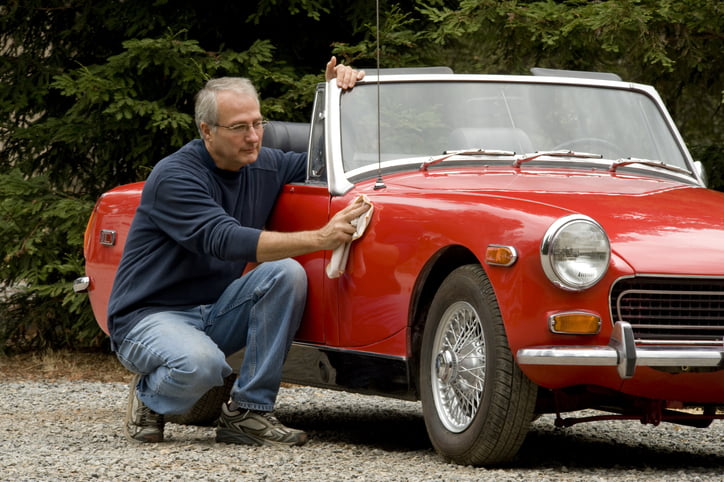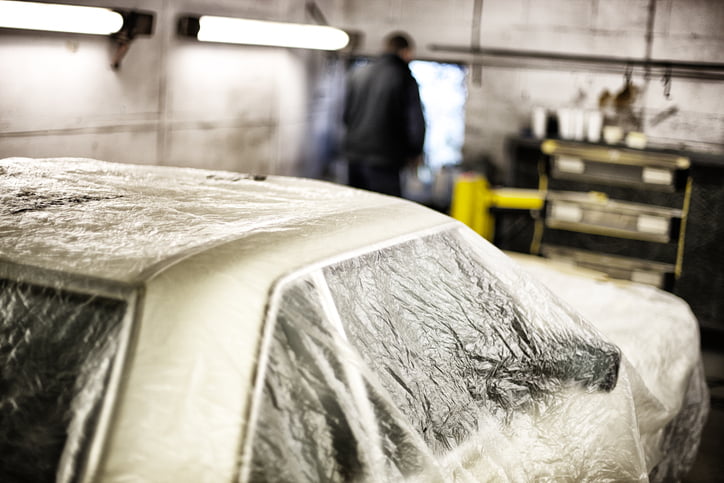If you’ve invested time and money in a classic car, then you’ll want to keep it in good condition. There will no doubt be long periods of time when you’re not using your classic car, whether that’s over winter or if you go away on holiday, and it’s important that you give thought to how you store it.
You’ll find tips and checklists in this guide which will help you to keep your classic car in good condition – use the quick links below to jump to the section you want.
- Where to Store a Classic Car
- How to Store and Lay-Up a Classic Car
- Maintenance Tips When Your Classic Car is in Storage
Where to Store a Classic Car
Where you store your classic car is important. The space needs to offer protection from
- weather
- temperature extremes
- moisture
and, of course, it needs to be secure.
Here, we look at some of the common places where classic cars are kept and provide tips on protecting your car from the elements.
Brick Garage
A brick garage offers the very best protection for a classic car, whether it’s attached to a house or a standalone unit. Bricks do a great job of maintaining a stable temperature and moisture-free environment, which is what you need for preventing condensation in cold conditions.
Good to know:
- If there’s a big gap under your garage door, consider covering your car to protect it in cold weather. This will help prevent condensation.
- Keep an eye on the temperature of your garage. If it gets cold in winter and hot in summer, you’ll need to take action to protect your car.
- Upgrade the locks on your garage door. Standard garage door locks can be easy to break, so consider adding padlocks to make it more secure.
- Open the car windows slightly so that air can circulate through it.
Pre-Cast Concrete or Wooden Unit
Other options for keeping a car inside include locking it in a pre-cast concrete or wooden compound, which you may have built specifically for housing your car. These are a quicker option if you don’t have the space, time or budget to build a brick garage, and will protect your car from the worst of the elements.
Alternatively, you could use a barn or outbuilding on your property, but we would recommend keeping the car covered in case animals or damp get in to it. You can now get pop-up structures like a gazebo which are easy to put up and keep your car relatively sheltered, so you could also consider one of these if you have the space.
Good to know:
- Concrete compounds can lack breathability, with a reduced flow of air making it more likely for mould and mildew to develop. To combat this, we’d recommend adding a couple of fans to the space every week or so, to circulate air and prevent things from going stale.
Outdoors
If your only option is to store your car outside, there are things you can do to protect it.
Invest in a cover which is purpose-built for your type of car; this will offer maximum protection and a close fit to prevent wind ‘rub’. If you can’t find a cover that’s built to the exact specification, go with one that’s slightly too big and then peg it in place so that everything’s covered. You need to protect it from direct sunlight as well as bird droppings, tree sap and moisture.
It’s also a good idea to lift your car off the ground if you can, as this will help protect the tyres, wheels and undercarriage from rain and moisture.
Good to know:
- Don’t use a standard tarpaulin to cover your classic car, only use a purpose-built car cover. Tarps and other general use plastic sheeting don’t offer the right kind of protection, and won’t let the car breathe, resulting in condensation, mould and mildew.

How to Store and Lay-Up a Classic Car
- Clean it inside and out – Removing any dirt, dust, salt or moisture from your car is essential before putting it in long-term storage. Substances like this can easily cause rust or corrosion when left on exposed surfaces, while dirt in the interior may cause mould or bad odours.
- Wax the paintwork – This will keep it protected against rust, moisture and other damage, and if you use a good hard wax it will last for a few months and still be shiny when you next take it for a drive. Inspect the paintwork regularly and treat any rust spots straight away.
- Lift the windscreen wipers – Lift them slightly away from the windscreen and make sure they’re clean and dry.
- Remove the battery – If you’re planning on laying up your car for any longer than a month, remove the battery to prevent it draining charge.
- Raise your car on to blocks and remove the wheels – Placing a classic car on to a set of jack stands is a good way of preserving the shape and condition of the tyres, and will also remove stress from the suspension.
- Use wheel chocks instead of the handbrake – Handbrakes can seize over time, so it’s a good idea to keep it off and instead hold the car in place with a set of wheel chocks.
- Open the windows to encourage air flow – It’s important that your car is well-ventilated in long-term storage. Opening the windows an inch will let air flow through the cabin. If this isn’t safe, use fans to air-out the cabin once a week.

Maintenance Tips When Your Classic Car is in Storage
- Check for condensation and moisture – Don’t let condensation gather inside the car, as this can lead to mould and bad odours.
- Turn the engine over – It’s important that oil circulates through the engine from time to time, to prevent internal parts from seizing up or developing faults. Aim to switch your car on and run it for 5 minutes every week.
- Take it for a spin – When the weather’s dry, it’s a good idea to take your car out for a drive, which will replenish the engine, charge the battery and improve air flow. Just remember to clean the undercarriage with a hose to remove salt and road dirt before laying it up again.
Visit the Redex blog for more classic car care tips and advice. Or, if you’d like to learn about the benefits of our petrol and diesel fuel system cleaners, click here for our homepage.

